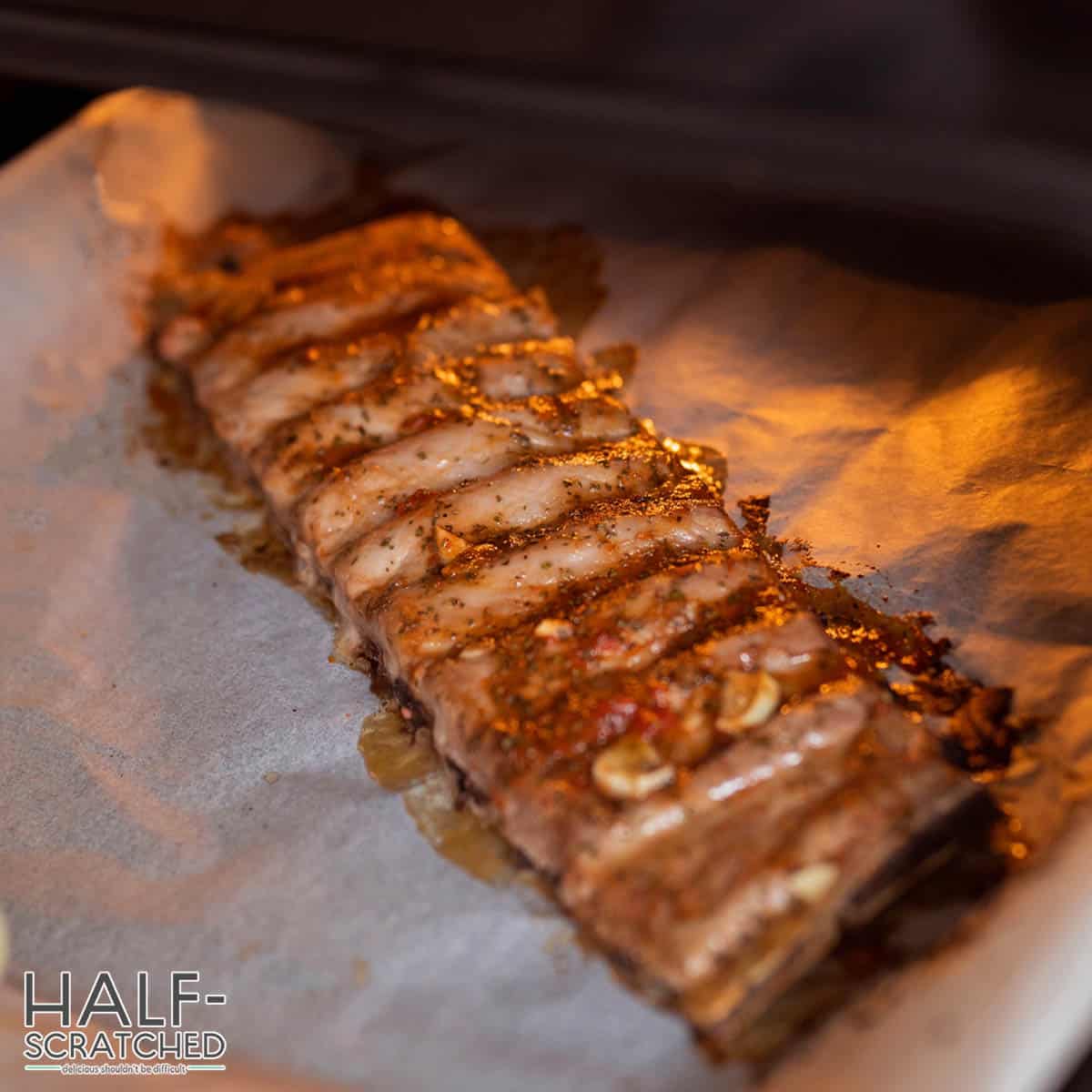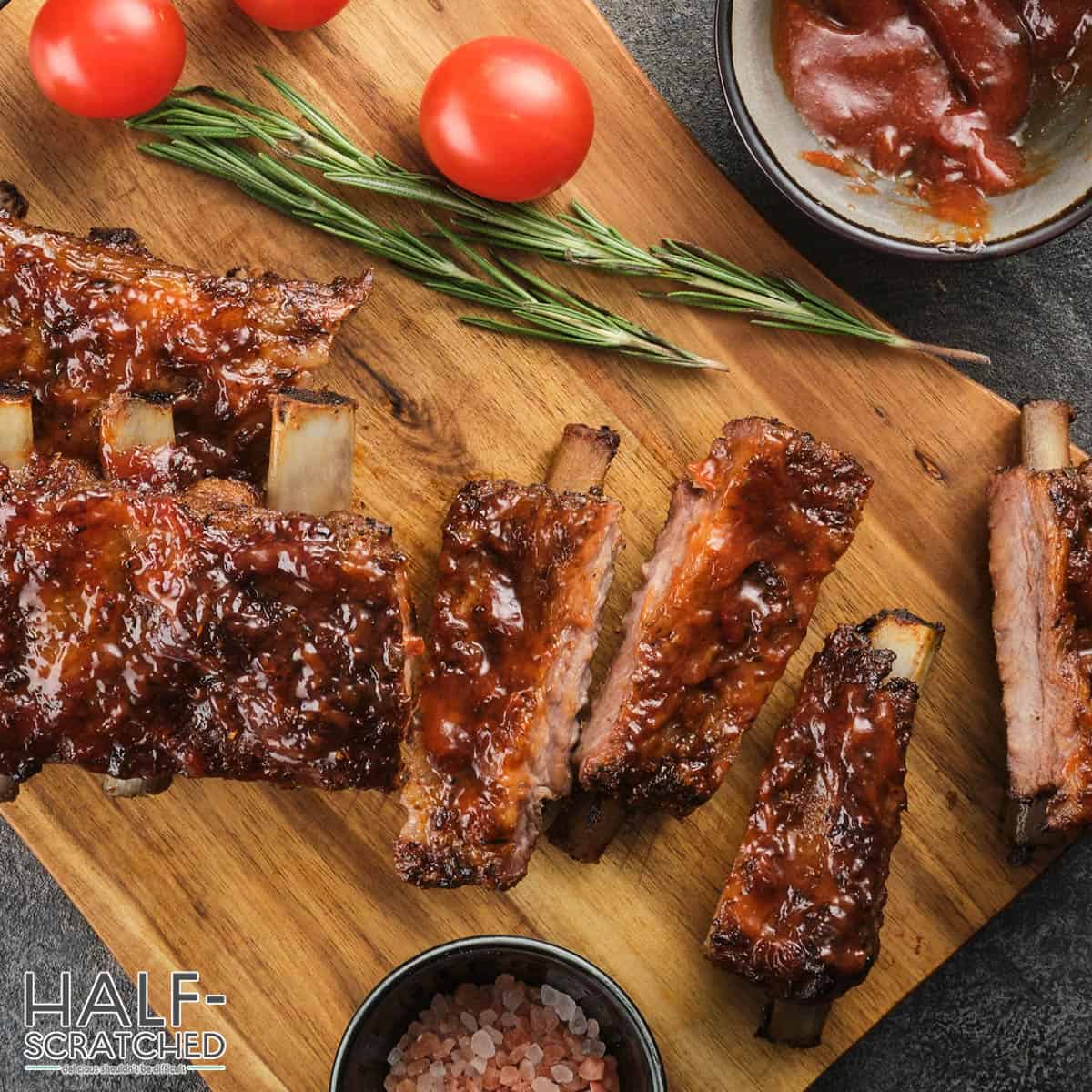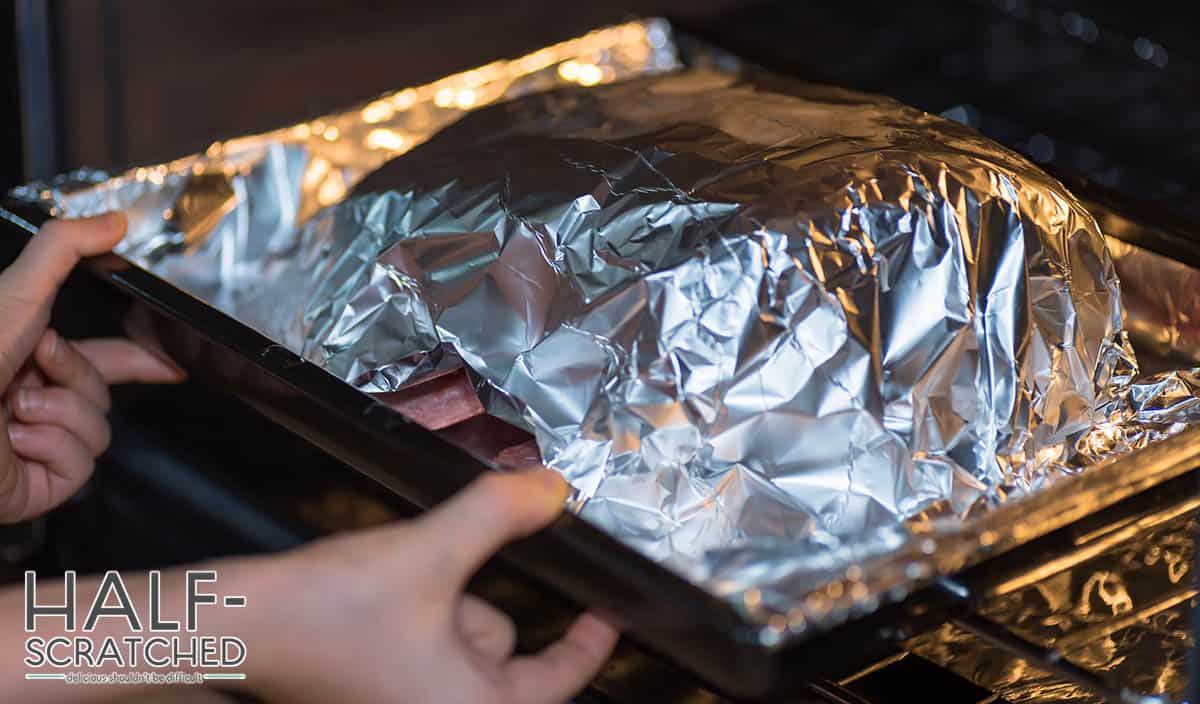Ribs with barbecue sauce are a wonderful summer staple and delicious alongside salads and baked potatoes. However, it can be a challenge to cook them so that they have a perfect melt-in-your-mouth texture. Here is some information about how long to cook ribs in the oven at 400 F.

For oven-baked ribs, the rule of thumb is to cook them for 30 minutes at 400°F for every pound of meat. So, if you're cooking a rack of pork ribs that weighs 3 pounds, you would cook them for 90 minutes at 400°F. If you prefer them extra tender and juicy, you can cook them for an additional 10-15 minutes or until the meat falls off the bone.
Ribs come in many varieties, though, so to master the art of oven-baking your meat, continue reading below. This guide will help you figure out how to perfectly cook ribs—whether spare, rack, pork, or beef—and explain some of the factors that can affect the quality of your final product.
Understanding the Different Cuts and Types of Ribs
When we talk about ribs, most people envision a slab or rack of twelve ribs slathered in barbeque sauce and slowly smoked over a wood fire. And while this is certainly one way to cook ribs, it's not the only way. In fact, there are several different types of ribs, each with its own unique flavor, texture, and cooking method.
The first thing you need to do when cooking ribs, then, is to understand the different types of ribs and how each one should be cooked. Here's a quick overview of the most common types of ribs, as well as some tips on how to cook each one.
- Beef Ribs: Beef ribs are the largest and most sinewy of the bunch and require a longer cooking time as a result. They're also the most flavorful, with a rich, beefy taste that pairs well with bold flavors, such as garlic, chili, and lime. When cooking beef ribs, aim for an internal temperature of 145°F for medium-rare, or 160°F for well-done.
- Pork Ribs: Pork ribs are the most popular type of rib, can be found in any grocery store, and come in two varieties. Spareribs are larger and tougher, while baby back ribs are smaller and more tender. Pork ribs are best cooked slowly, whether that means smoking them, braising them, or cooking them in the oven. Pork is done cooking when it reaches an internal temperature of 145°F.
- Lamb Ribs: Lamb ribs are the smallest and most delicate of the bunch, with a sweet, gamey flavor. They cook quickly, so it's easy to overcook them if you're not careful. When cooking lamb ribs, aim for an internal temperature of 145°F for medium-rare or 160°F for well-done.
- Back Ribs: Back ribs are relatively small and fatter than front ribs and cook quite quickly. Racks of short ribs weigh between 1 and 2 Ibs, and may also refer to them as loin ribs or baby back ribs.
- Spare Ribs: Spare ribs are longer and leaner ribs from the belly located behind the shoulder. Because of their weight, the racks cook more slowly. When these ribs are trimmed of cartilage, breastbone, and the skirt to form a rectangular rack, they are often referred to as side ribs or St. Louis-style ribs.
- Country Style Ribs: Typically, these rib steaks come from the shoulder portion of the loin and cook more quickly than the other types. Some are boneless, while others feature shoulder blades, as shown here. These are also known as shoulder steaks and blade chops.
Now that you know the different types of ribs, as well as the recommended cooking temperatures for each variety, you're ready to start cooking. Read on for tips on how to cook ribs in the oven, as well as some ideas for flavorings and sauces.

How Long Will it Take to Cook Ribs at 400°
As you can probably tell, the amount of time it will take to cook your ribs depends on a handful of things, including the type of meat, the size of the ribs, and your preferred tenderness. In general, though, you can expect to cook pork ribs for 30 minutes at 400°F for every pound of meat.
Beef will take a little longer to tenderize, though, so we recommend flipping the ribs every 45 minutes for three hours. After that point, you can check the internal temperature of the meat to see if it's reached the desired level of doneness.
As for lamb, the cooking time will depend on the size of the rack. A small rack of lamb ribs should cook for about 25 minutes, while a large rack may take up to 45 minutes. Remember, though, that these are just guidelines. The best way to know for sure when your ribs are done is to use a meat thermometer.
For pork and beef, you're looking for an internal temperature of 145°F for medium-rare or 160°F for well-done. For lamb, the recommended internal temperature is 145°F for medium-rare or 160°F for well-done.
Once the ribs have reached the desired level of doneness, remove them from the oven and let them rest for 5-10 minutes before cutting into them. This will give the juices a chance to redistribute, ensuring that your ribs are as moist and flavorful as possible.

Wrapping the Meat in Aluminum Foil
Another way to ensure that your ribs are nice and juicy is to wrap them in aluminum foil. This will create a steamy environment that will help to break down the collagen and make the meat more tender. To wrap your ribs in aluminum foil, simply place them on a large sheet of foil, and then fold the edges up, so that the ribs are completely enclosed.
Make sure that you don't wrap the foil too tightly, though, as you need to leave some room for the steam to circulate. Once your ribs are wrapped, place them back in the oven and continue cooking them according to the recipe instructions. Once finished, carefully open the foil (being careful not to burn yourself), and let the ribs rest for 5-10 minutes before cutting into them.

The Cooking Time for Boneless Ribs Vs Bone-in Ribs
Generally speaking, bone-in ribs require 10% more cooking time than boneless ribs. In addition to pork or beef ribs, this rule also applies to other meat such as chicken, salmon, or lamb. For example, if the recommended time for boneless ribs is 1 hour, then, bone-in ribs will take about 1 hour and 10 minutes longer.
The internal temperature of the ribs must be between 185 F and 200 F.
Baking Ribs with a Sauce vs. Adding the Sauce at the End
Many cooks question whether or not they should add sauce to their ribs before cooking them or wait until after they're done. The answer to this question is entirely up to you and will depend on the type of sauce you're using, as well as your personal preferences.
If you're using a wet sauce, such as a barbeque sauce or sweet and sour glaze, we recommend adding it to the ribs during the last 20-30 minutes of cooking. This will give the sauce time to caramelize and form a delicious crust on the ribs, without burning.
If you're using a dry rub, on the other hand, we recommend adding it to the ribs before cooking. This will give the spices a chance to penetrate the meat, ensuring that your ribs are evenly seasoned.
In general, though, we recommend adding sauce to the ribs during the last 20-30 minutes of cooking, regardless of the type of sauce you're using. A final coating will help to keep the ribs moist and add a fresh layer of flavor that's not as heavily darkened or caramelized.

Effects of Baking Ribs at a Lower Temperature
If you're short on time, you may be tempted to cook your ribs at a higher temperature, such as 425°F or 450°F. While this will shorten the overall cooking time, it's not necessarily the best way to achieve tender, juicy ribs. The reason has to do with the collagen in the meat.
When cooked at a lower temperature, the collagen has a chance to break down, which makes the meat more tender. When cooked at a higher temperature, the collagen doesn't have a chance to break down, which results in tougher, less flavorful meat.
So, if you're looking for tender, juicy ribs, we recommend sticking to a lower temperature, such as 400°F or even 350°F. This may take a bit longer, but the end result will be worth the wait. Otherwise, you'll end up with chewy ribs that lack that iconic fall-of-the-bone consistency.
Using an Air Fryer to Cook Ribs
If you're short on time, you can speed up the cooking process by using an air fryer rather than baking your ribs in the oven. Set the air fryer to 350°F and cook the ribs for thirty minutes. They will cook faster than in the oven, so be sure to flip the meat over around the 15 minutes mark and test for tenderness.
Continue cooking the ribs until the meat has reached a safe internal temperature and is tender to your liking. Although you likely won't be able to cook an entire rack of ribs in the air fryer, this is a quick and easy way to prepare two or three spare ribs.
My Personal Tips for Preparing Ribs
Before we get into a specific recipe, we wanted to share a few general tips to help you create the best ribs you've ever made. Check them out below and apply them as you see fit.
- Marinate your ribs for at least 2 hours before cooking. If possible, let them marinate overnight in a bath of ingredients that includes some form of salt, acid, and sugar, such as soy sauce, fruit juice, or just simple table salt, vinegar, and sugar. These ingredients will penetrate into the meat and help to create a tender, juicy final rib.
- If you prefer to use a dry rub, season your ribs for at least 30 minutes before cooking. This will give the spices time to penetrate the meat and create a flavorful crust when you bake the ribs. If your rub contains sugar, be careful during the cooking process to avoid burning the outer layer.
- Line a baking sheet with foil and place a wire rack on top of the foil. This will prevent the ribs from sticking to the pan and will also allow the heat to circulate evenly around the ribs. The more heat that circulates, the more evenly your ribs will cook, helping to speed up the overall cooking time.
- Remove the ribs from the oven and let them rest for 5-10 minutes before cutting into them. This will allow the juices to redistribute throughout the meat, making them even more tender and juicy. If you cut into the meat immediately after removing it from the oven, the juices will escape, and you'll end up with a dry cut of meat.

What to Serve With Baked Ribs
The baked ribs are a delicious snack or dinner. They can be served with fries, dipping sauces, and roasted vegetables such as carrots, asparagus, or tomatoes. The baked ribs can also be served as a more formal dinner with mashed potatoes and BBQ sauce accompanied by lemon slices.
Frequently Asked Questions
The membrane is a thin layer of connective tissue that covers the back of the ribs. It's tough and chewy and is best removed before cooking.
The easiest way to remove the membrane is to use a paring knife to loosen one end and then use your fingers to peel it away from the meat.
Yes! Ribs can be cooked up to 2 days in advance. Store them in the fridge, or freeze them for up to 3 months.
The best way to reheat ribs is in the oven. Preheat the oven to 350°F and place the ribs on a baking sheet lined with foil. Cook for 10-15 minutes, or until heated through.
Leftover baked ribs can last in the fridge for 3 to 4 days. Make sure to let the ribs cool until they reach room temperature and then place them into airtight glass containers to refrigerate them.
As long as the ribs are stored properly, you can freeze them for up to 3 months. Let the ribs rest at room temperature after baking. Once the ribs have been cut into portions, lay each piece on a large piece of plastic film wrap. Make sure the ribs are tightly wrapped, and squeeze out all of the air. To add extra protection, place wrapped portions inside a heavy-duty freezer bag. It is a good idea to label the freezer bags with the freezing date.

How Long to Cook Ribs in the Oven at 400 F
Nothing beats a slab of tender baby-back ribs slow-cooked in the oven, ready to fall off the bone.
Ingredients
- 1 slab of baby back pork ribs
- 1 teaspoon paprika
- 1 teaspoon garlic powder
- 1 teaspoon onion powder
- 1 teaspoon black pepper
- ½ teaspoon cumin
- ¼ cup apple cider vinegar
- 1 cup ketchup
- ½ cup brown sugar
- ¼ cup molasses
- ¼ cup Worcestershire sauce
Instructions
- Preheat the oven to 400 degrees Fahrenheit.
- Combine paprika, garlic powder, onion powder, black pepper, and cumin in a small bowl. Rub the spice mixture all over the pork rib and let sit for 30 minutes.
- Place the pork ribs in a large baking dish or directly onto the oven grate with an aluminum-wrapped baking sheet placed below.
- In a medium bowl, whisk together apple cider vinegar, ketchup, brown sugar, molasses, and Worcestershire sauce. Pour or brush the sauce over the pork ribs.
- If using a baking dish, cover it with foil and bake for 2 hours, or until the pork ribs are very tender.
- Remove the foil, add your preferred barbeque sauce, and bake for an additional 30 minutes or until the sauce is caramelized.
- Cut the pork ribs into individual servings and enjoy!
Nutrition Information:
Yield: 2 Serving Size: 1Amount Per Serving:Calories: 530Total Fat: 6gSaturated Fat: 2gTrans Fat: 0gUnsaturated Fat: 3gCholesterol: 18mgSodium: 1475mgCarbohydrates: 120gFiber: 1gSugar: 105gProtein: 6g


Kenneth Brown
Very good instructions on baking Spare Ribs. Let's get busy.